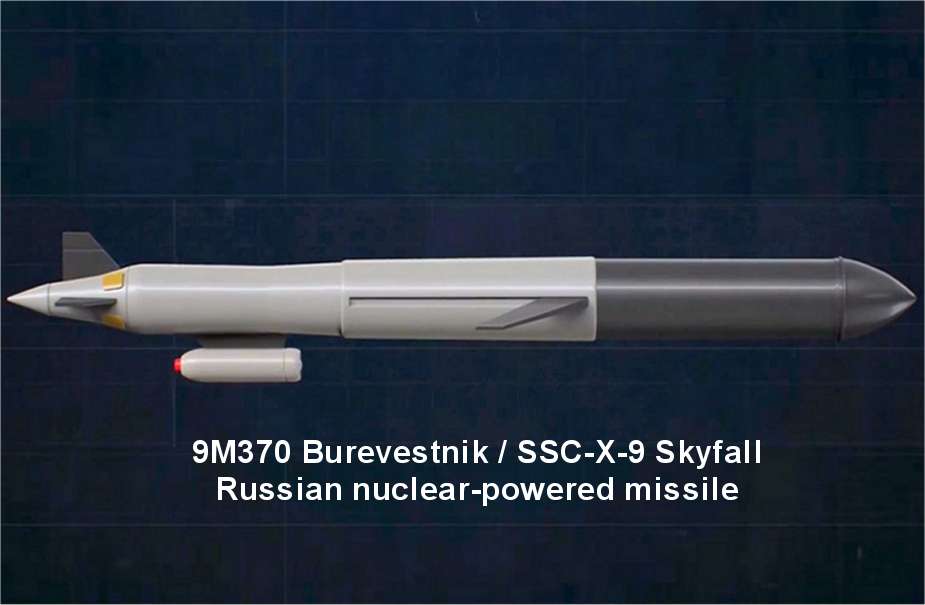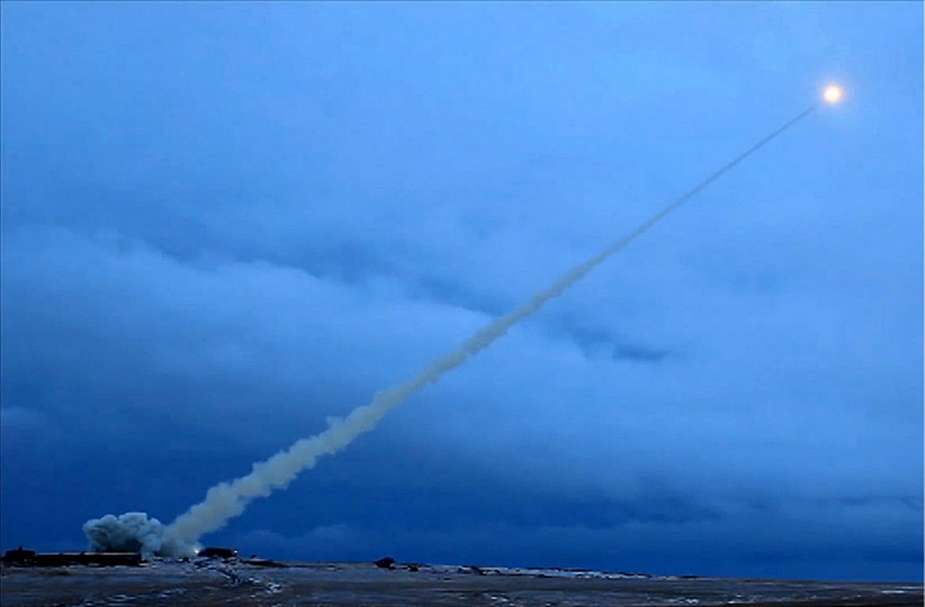Breaking news
Russia to test Burevestnik nuclear missile toward Barents Sea.
According to an article published by the Barents Observer on September 15, 2023, Russia is reportedly preparing for a new test of its 9M370 Burevestnik nuclear-powered cruise missile, known by its NATO designation as SSC-X-9 Skyfall. Heightened activity has been observed on the New Siberian Islands, particularly at the Pankovo test site, believed to be linked to the Burevestnik tests. This information is based on frequently updated satellite imagery, ship tracking data, and Notices to Airmen (NOTAMs) and navigational warnings (PRIPs) issued since August.
Follow Army Recognition on Google News at this link

The 9M370 Burevestnik nuclear-powered missile (Picture source Russian MoD)
It is also suggested that a missile launched from the Pankovo site may be directed toward the Barents Sea or a target north of the New Siberian Islands.
The exact timing of this impending test, if indeed it is imminent, remains uncertain. The first NOTAM was issued on August 31, and its extension until September 24 indicates that the launch may happen in the near future. Norwegian authorities are closely monitoring the situation, particularly regarding potential radioactive emissions. Admiral Nils Andreas Stensønes, the head of Norwegian military intelligence, expressed these concerns to the Barents Observer, stating, "Intelligence services closely monitor Russian weapon programs and tests, including this one," without providing further details.
This development is part of a larger weapons program unveiled by Russian President Vladimir Putin in March 2018, which includes the hypersonic Kinjal missile, the nuclear-powered Poseidon torpedo system, and the 9M730 Burevestnik missile. It's important to note that the Burevestnik project shares similarities with a concept explored by the United States almost six decades ago under the "Pluton" program. However, the American initiative was eventually abandoned due to significant financial investments and formidable technical challenges.
According to a recent publicly available report titled Focus 2023 published by Norwegian military intelligence on January 27, 2023, Russia is committed to continuing the development of the nuclear-powered Poseidon torpedo system, one of the six weapons introduced by Putin, along with the 9M730 Burevestnik. The report anticipates "further tests on the New Siberian Islands" and estimates that several more years of development will be necessary before these systems become fully operational.
The question now is whether the anticipated tests, as suggested by Norwegian intelligence, are indeed imminent. Recent intelligence missions conducted in Northern Europe under NATO's supervision have noted an escalation in recent days, contributing to concerns. Notably, there has been an expansion of surveillance flights in Finnish airspace, bringing them closer to Russia's Murmansk region, indicating heightened tensions.
The development of the 9M730 Burevestnik has faced significant challenges and setbacks since its inception, impeding its progress toward full operational capability, similar to other Russian military programs like the T-14 Armata tank or the Kurganets-25 IFV. According to intelligence sources, the nuclear-powered Burevestnik missile underwent at least four tests between November 2017 and February 2018, all of which reportedly ended in failure.
There have been unverified reports suggesting that a prototype of the missile was lost in the Barents Sea, an area historically associated with nuclear testing, especially in the 1950s. Speculation surrounding this incident intensified due to the presence of the KIL-143 crane ship within a flotilla deployed to the area in August 2018.
A year later, an unexpected increase in radiation levels occurred in Severodvinsk following an explosion at the Nyonoksa base in the Arkhangelsk Oblast. This incident revived suspicions surrounding the 9M730 Burevestnik. Although preparations for a new test of the missile on the New Siberian Islands were reported in August 2021, it remains uncertain whether this test was ultimately conducted.

The development of the 9M730 Burevestnik has faced significant challenges and setbacks since its inception (Picture source: Russia MoD)
The Burevestnik missile, also known as SSC-X-9 Skyfall in NATO reporting, was publicly revealed by Russian President Vladimir Putin in 2018. It is characterized by a high degree of secrecy, and there is limited available information concerning its development and capabilities compared to other Russian military projects. The estimated unit cost is approximately $5,200,000.
The missile features an angular design aimed at minimizing its radar signature and bears some resemblance to the Kh-101 aircraft cruise missile, albeit larger in size. Unlike the Kh-101, which has its wings at the bottom, the Burevestnik's wings are located on the upper part of the missile, and these wings are notably larger than those of the Kh-101.
At launch, the Burevestnik missile measures about 12 meters in length. During its flight, its length is estimated to be between 9 and 11 meters, with an elliptical nose measuring 1 meter by 1.5 meters.
What sets the Burevestnik apart from conventional missiles is its use of an onboard nuclear reactor as a propulsion system, enabling extended flight ranges and prolonged loitering capabilities.
Powered by a pulsed nuclear air-breathing engine that potentially utilizes graphite as a moderator and compressed atmospheric air as a coolant, the missile generates thrust by heating atmospheric air through compact nuclear-powered heaters. The heated air also serves as the working fluid for the missile's engine. It incorporates an air valve within its propulsion jet engine to prevent the reverse movement of the working fluid, a feature not commonly found in ramjet engines.
Launching the Burevestnik missile from conventional aircraft, such as the Tu-95MS and Tu-160 bombers, may not be feasible due to its size, nuclear reactor, and heavy heaters. As an alternative launch method, ground-based launchers, including mobile ones, have been proposed.
The missile's nuclear propulsion system provides it with the capability to follow unconventional flight trajectories, making it challenging for adversaries to predict, track, and intercept. It has been designed with advanced stealth technology, significantly reducing its radar cross-section, especially when flying at low altitudes.
Navigation during extended flights, which can last for hours or even days, poses a significant challenge for the Burevestnik missile, particularly over vast bodies of water where there are no terrain references. Concerns have been raised regarding potential radiation emissions during flight, although efforts have been made to minimize them since any detectable radiation could potentially reveal the missile's presence.
While there have been reports of successful test flights, the development of a reliable navigation system tailored to the missile's operational requirements is considered crucial for its eventual deployment.




























